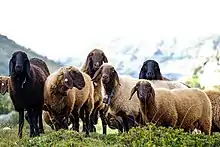 Red Engadine in two colour variations, brown and black (Switzerland) | |
| Conservation status | |
|---|---|
| Other names |
|
| Country of origin | Switzerland |
| Distribution | Lower Engadine, parts of Bavaria and Tyrol |
| Type | Alpine lop-eared |
| Use |
|
| Traits | |
| Weight | |
| Height | |
| Wool colour | fox-red |
| Face colour | dark |
| Horn status | polled |
| |

.jpg.webp)
The Red Engadine or Engadine Red is a traditional Swiss breed of domestic sheep from the Lower Engadine valley and some neighbouring parts of Bavaria and Tyrol. It derives from cross-breeding of stock of Bergamasca and Alpines Steinschaf type.[3]: 804 It is characterised by its convex profile, its fox-red wool and its long lop ears.[3]: 804 In the 1980s it became gravely endangered, but has since recovered.[3]: 804 [1]: 112 It is a hardy mountain sheep; the hooves are strong and hard, and the breed is one of the few that are reported to have good resistance to foot rot.[4]: 107
History
The Red Engadine is a long-established traditional mountain sheep breed of the Lower Engadine valley, in the canton of Graubünden in south-eastern Switzerland, and some neighbouring parts of Bavaria in Germany and Tyrol in Austria.[3]: 804 It derives from cross-breeding of sheep similar to the modern Bergamasca, brought by Italian shepherds to the Alps of eastern Switzerland, with indigenous stock of Alpines Steinschaf type.[5]
During the twentieth century it was gradually displaced by faster-growing breeds such as the Weisse Alpenschaf,[5] and by the 1980s it was gravely endangered.[3]: 804 With the assistance of ProSpecieRara, measures were taken to recover the breed:[6] in 1985 a flock-book was started, and in 1992 a breed society, the Schweizerischer Engadinerschaf-Zuchtverein, was formed.[3]: 804 [7] Between 1992 and 2001 the recorded population rose from 40 breeding rams and 250 ewes to 136 rams and 1381 ewes.[8] In 2007 the breed was listed by the FAO as "not at risk";[1]: 112 in 2020 its conservation status was reported to DAD-IS as "at risk".[2]
Characteristics
The Red Engadine is characterised by a convex profile, a fox-red coat, and long lop ears;[3]: 804 the coat may fade in the sun. The face is dark, which together with the long drooping ears may give the animal a monkish appearance; this has given rise to names such as Romansh: Besch da Pader and German: Paterschaf for the breed.[3]: 804 [9]: 140
It is a hardy mountain sheep; the hooves are strong and hard, and the breed is one of the few that are reported to have good resistance to foot rot.[4]: 107
Use
The Red Engadine is reared principally for meat. It is slow-growing in comparison to some other breeds, but shows high prolificity – it is an aseasonal breeder, with a high twinning rate and short lambing interval of seven to eight months.[5][6] The meat is of high quality and is low in fat.[10]: 189 [11]
Unlike more widespread breeds such as the Weisses Alpenschaf, it browses on woody stems as well as grass. It has been shown to be effective in limiting the spread of the invasive Alnus alnobetula (= Alnus viridis, "green alder") which threatens montane pasture land in the Alps and elsewhere.[10]: 189 [12]: 76
References
- 1 2 3 Barbara Rischkowsky, Dafydd Pilling (editors) (2007). List of breeds documented in the Global Databank for Animal Genetic Resources, annex to The State of the World's Animal Genetic Resources for Food and Agriculture. Rome: Commission on Genetic Resources for Food and Agriculture, Food and Agriculture Organization of the United Nations. ISBN 9789251057629. Archived 23 June 2020.
- 1 2 3 4 Breed data sheet: Engadiner Schaf / Switzerland (Sheep). Domestic Animal Diversity Information System of the Food and Agriculture Organization of the United Nations. Accessed December 2020.
- 1 2 3 4 5 6 7 8 9 10 Valerie Porter, Lawrence Alderson, Stephen J.G. Hall, D. Phillip Sponenberg (2016). Mason's World Encyclopedia of Livestock Breeds and Breeding (sixth edition). Wallingford: CABI. ISBN 9781780647944.
- 1 2 Barbara Rischkowsky, Dafydd Pilling (editors) (2007). The State of the World's Animal Genetic Resources for Food and Agriculture. Rome: Commission on Genetic Resources for Food and Agriculture, Food and Agriculture Organization of the United Nations. ISBN 9789251057629. Archived 10 January 2017.
- 1 2 3 Mouton d'Engadine (in French). St. Gallen: ProSpecieRara. Archived 21 September 2020.
- 1 2 [s.n.] (2007). Le Mouton d’Engadine (in French). Geneva: Muséum d'histoire naturelle, Ville de Genève. Archived 18 July 2018.
- ↑ Das Engadinerschaf - mehr als ein Schaf... (in German). Schweizerischer Engadinerschaf Zuchtverein. Archived 27 November 2020.
- ↑ Breed description: Red Engadine Sheep. Department of Animal Breeding and Genetics, School of Veterinary Medicine Hannover. Archived 15 October 2007.
- ↑ Hans Haid (2010). Das Schaf: eine Kulturgeschichte (in German). Viena: Böhlau Verlag. ISBN 9783205784425
- 1 2 Tobias Bühlmann, Erika Hiltbrunner, Christian Körner (2014). Alnus viridis expansion contributes to excess reactive nitrogen release, reduces biodiversity and constrains forest succession in the Alps. Alp Botany (124): 187–191. doi:10.1007/s00035-014-0134-y.
- ↑ Helen Willems, Michael Kreuzer, Florian Leiber (2013). [https://www.sciencedirect.com/science/article/abs/pii/S1871141312004003 Vegetation-type effects on performance and meat quality of growing Engadine and Valaisian Black Nose sheep grazing alpine pastures. Livestock Science 151 (1): 80–91. doi:10.1016/j.livsci.2012.10.015. (subscription required).
- ↑ Beate Scherf, Dafydd Pilling (editors) (2015). The Second Report on the State of the World's Animal Genetic Resources for Food and Agriculture. Rome: Commission on Genetic Resources for Food and Agriculture, Food and Agriculture Organization of the United Nations. ISBN 9789251088203. Archived 24 March 2016.
Further reading
* Christian Gazzarin (editor) (2018). Schafgeschichte & Lammgerichte (in German). Hinterforst: Spriessbürger Verlag. ISBN 9783952452431.